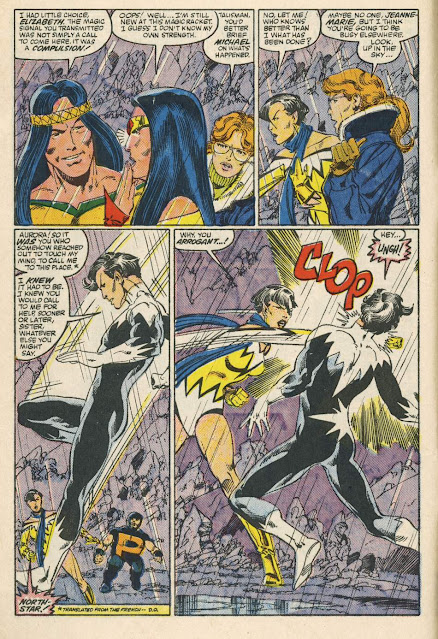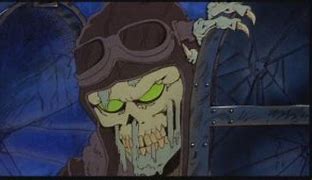Bill Mantlo's tenure on the original ALPHA FLIGHT series wasn't much more distinguished than that of the feature's creator John Byrne. Yet curiously, one of the few times Mantlo delves into the world of epistemological myth was a story in which he was clearly attempting to jettison a couple of characters he didn't like writing-- that is, Northstar and Aurora, whose history I briefly examined in TWINSANITY.
To the extent "Mortal Coil" is remembered at all, it's as the issue in which writer Mantlo made the big reveal that ambiguously gay superhero Northstar was actually a "fairy"-- but in the literal sense (though this didn't keep some commenters from assuming that this revised origin was meant as gay-bashing). Such invidious remarks didn't take into account (1) that Mantlo was also stating that Aurora, who was not gay/lesbian, shared the same human/fairy heritage, and (2) that Mantlo was a fairly conspicuous Liberal, who was unlikely to have been bashing even an implicit gay character.
Bill Mantlo took over writing the regular ALPHA FLIGHT title after John Byrne departed with issue #28, and he continued on the feature until issue #66. I would judge Byrne's stories to be no more than standard Marvel soap-operatics, in which a team of disparate individuals bounce off one another with lots of emoting and hand-wringing in place of substantial characterization. Mantlo's run was largely more of the same, and it can be argued that he made an honest attempt to follow through on most of the character-arcs Byrne had established. The two authors had roughly opposite strengths and weaknesses. Byrne could not plot an arc to save his life, but he was able to give his characters distinct voices. Mantlo was a better plotter, but all of his characters talk like they just graduated Exposition 101.
I glanced over the Mantlo issues prior to "Coil," and for the most part he keeps the Byrne status quo with respect to the mutant twins. Northstar is jealous of Aurora's dalliance with men in a way that would seem incestuous were he not supposed to be implicitly homosexual. As it is, Brother Northstar just comes off as judgmental for no particular reason. After the death of Aurora's former lover Sasquatch, she begins a love-affair with technician Roger Bochs, a legless paraplegic. Throughout these issues, Aurora's split personality remains unaltered, and her superhero persona is that of a flirt who has only light, insubstantial loves. Mantlo clearly had no interest in improving the fractious characters, and "Coil" is a story in which he sought to get rid of the twins-- and, for that matter, another Byrne original, the dwarf-hero Puck.

Since issue #44, Mantlo introduced the notion that Northstar had a "pre-existing disease" that made him cough in every succeeding issue. Unconfirmed rumors of the period asserted that Mantlo meant to imply that Northstar had contracted AIDS and to have the mutant hero perish of that disease. Allegedly, Marvel Editorial refused to let him make even indirect allusions to homosexuality, so Mantlo revised whatever plans he had to rid himself of the mutant siblings. Thus, Northstar's illness, as well as Aurora's mental instability, become serious enough that the team takes both of them to a potential place of healing, a mystical conduit that links to many of the Marvel magic-worlds.


Despite some nice art by June Brigman, most of the perils the Alphans face are standard and uninvolving. Thus there's some irony to my assertion Mantlo saved his creative energies to craft a new origin for the characters, just so that he could be rid of them. This new origin claims that the twins' mortal father, who died before either sibling could have met him, found his way into the Faerie World, and caught a female elf, Danae, who wanted to be caught by him. However, after the two were married and Danae conceived the twins, an Elf Purity Squad tracked the wayward fairy down. The twins' father expires in an accident and Danae, despite being immortal, perishes for some reason Mantlo does not bother to discuss.


This revelation by Loki, Norse God of Mischief, is taken at face value by both twins as they seek to survive in the darkness of the conduit. This situation engenders the closest thing the two characters have to a "mythic moment." John Byrne, during some of his last issues, had Aurora declare her independence from her snobby brother by altering her genetic makeup so that the two of them lost their powers when they made physical contact. Faced with the prospect of death in an otherworld, Aurora makes a sacrifice, radiating her store of light-energy-- which I guess is now mystical in nature-- into her brother's body. This depletes her so that Aurora is captured by some of the conduit's demonic denizens.


Northstar locates the rest of Alpha Flight, but because their leader Vindicator is suddenly antsy about letting the demons out of the gate the heroes opened, she then seals it, with both Aurora and Puck inside. With two of the three characters Mantlo didn't want to write out of the way, he then came up with a way to usher Northstar into the Faerie-World of his mother's race-- though it's not clear why the elves suddenly welcomed a half-elf, half-human when twenty-something years ago they wanted to keep their bloodlines pure.

The book's heroes have to slink away with their tails between their legs, but Mantlo makes certain that the readers don't condemn him for consigning two regular characters to horrible fates. I won't get into Puck's disposition, except to say that he's relieved of an ongoing curse. Loki then tells some irate deities that Aurora, by hurling all of her light-force into her brother, not only cured him but purged her own elf-nature as well. Loki claims he delivered her to some unspecified mortal custodians and that he supposedly cured her of her split personality.
I don't pretend that "Coil" is a good story, and as soon as Mantlo left the feature, the subsequent writer reversed the "half-elf" solution and both Northstar and Aurora came back, though I haven't re-visited at those stories for years. But I will give Mantlo some credit for coming up with a climax for the Northstar-Aurora sibling relationship, in marked contrast to the characters' creators John Byrne, who was content to have them simply snipe at one another endlessly. The idea of Aurora surrendering her essence to cure her ailing brother could even carry a loose clansgressive motif, which plugs in to Northstar's jealousy of his sister's sexual relationships-- though I won't claim that this was intentional on Mantlo's part. The name he gives to the twins' elfin mother also has an inverted connection to the use of "light" to signify "intercourse." In Greek mythology, the mortal maiden Danae begets Perseus after the hero's godly father Zeus appears to Danae as a "golden shower," usually translated as rain, though the shower's color has stronger associations with sunlight. And though I don't have reason to think Mantlo a "mythophile," it's interesting that the name Danae resembles a Celtic name for the faerie-folk: the "Tuatha de Danaan."









































